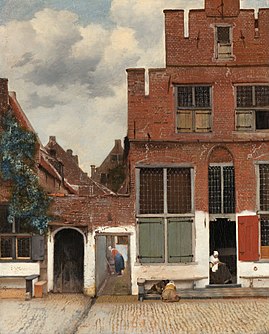
Delft is a city and municipality in the province of South Holland, Netherlands. It is located between Rotterdam, to the southeast, and The Hague, to the northwest. Together with them, it is a part of both the Rotterdam–The Hague metropolitan area and the Randstad.

Johannes Vermeer was a Dutch Baroque Period painter who specialized in domestic interior scenes of middle-class life. He is considered one of the greatest painters of the Dutch Golden Age along with Rembrandt. During his lifetime, he was a moderately successful provincial genre painter, recognized in Delft and The Hague. He produced relatively few paintings, primarily earning his living as an art dealer. He was not wealthy at his death, leaving his wife in debt.
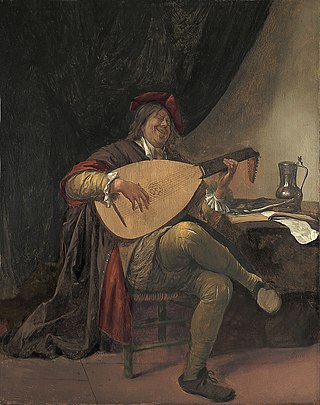
Jan Havickszoon Steen was a Dutch Golden Age painter, one of the leading genre painters of the 17th century. His works are known for their psychological insight, sense of humour and abundance of colour.

The Milkmaid, sometimes called The Kitchen Maid, is an oil-on-canvas painting of a "milkmaid", in fact, a domestic kitchen maid, by the Dutch artist Johannes Vermeer. It is now in the Rijksmuseum in Amsterdam, the Netherlands, which regards it as "unquestionably one of the museum's finest attractions".
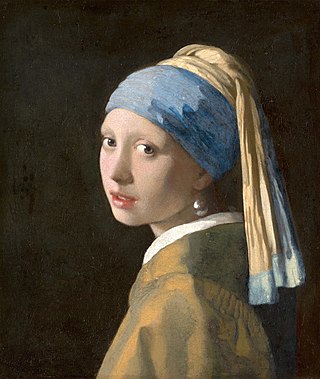
Girl With A Pearl Earring is an oil painting by Dutch Golden Age painter Johannes Vermeer, dated c. 1665. Going by various names over the centuries, it became known by its present title towards the end of the 20th century after the earring worn by the girl portrayed there. The work has been in the collection of the Mauritshuis in The Hague since 1902 and has been the subject of various literary and cinematic treatments.
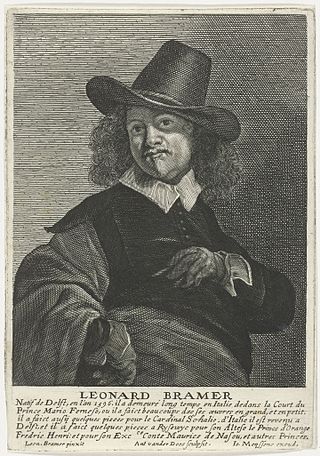
Leonaert Bramer, also Leendert or Leonard, was a Dutch painter known primarily for genre, religious, and history paintings. Very prolific as a painter and draftsman, he is noted especially for nocturnal scenes which show a penchant for exotic details of costume and setting. He also painted frescos—a rarity north of the Alps—which have not survived, as well as murals on canvas, few of which are extant. Bramer is one of the most intriguing personalities in seventeenth-century Dutch art.

Saint Praxedis is an oil painting by Johannes Vermeer. This attribution has often been questioned. In 2014 the auction house Christie's announced the results of new investigations which in their opinion demonstrated it conclusively to be a Vermeer. In the 2023 Vermeer exhibition held by the Rijksmuseum, the museum conducted an investigation and concluded it is painted by Vermeer. The painting is a copy of a work by Felice Ficherelli, and depicts the early Roman martyr, Saint Praxedis or Praxedes. It is one of Vermeer's earliest surviving works, dating from 1655.
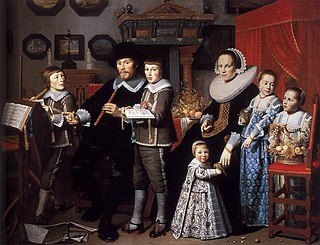
Hendrick Corneliszoon van Vliet was a Dutch Golden Age painter remembered mostly for his church interiors.

Frederik Hendrik Kreuger, was a Dutch high voltage scientist and inventor, lived in Delft, the Netherlands, and was professor emeritus of the Delft University of Technology. He was also a professional author of technical literature, nonfiction books, thrillers and a decisive biography of the master forger Han van Meegeren.

Christ in the House of Martha and Mary is a painting finished in 1655 by the Dutch Golden Age painter Johannes Vermeer. It is now in the Scottish National Gallery in Edinburgh. It is the largest painting by Vermeer and one of the very few with an overt religious motive. The story of Christ visiting the household of the two sisters Mary of Bethany and Martha goes back to the New Testament. The work has also been called Christ in the House of Mary and Martha.

Officer and Laughing Girl, also known as Officer and a Laughing Girl, Officer With a Laughing Girl or De Soldaat en het Lachende Meisje, was painted by the Dutch artist Johannes Vermeer between 1655 and 1660. It was painted in oil on canvas, typical of most Dutch artists of the time, and is 50.5 by 46 cm. It is now one of three pictures by Vermeer in The Frick Collection in New York

Girl with a Red Hat is a rather small painting, signed by the Dutch painter Johannes Vermeer. It is seen as one of a number of Vermeer's tronies – depictions of models fancifully dressed that were not intended to be portraits of specific, identifiable subjects. Whether Vermeer chose family members as models or found them elsewhere in Delft is irrelevant to the appreciation of his paintings. Its attribution to Vermeer – as it is on a (recycled) wood panel and not on canvas – has been a matter of controversy with scholars on both sides of the argument. However, in recent study carried out by the curators of National Gallery of Art certainty has been established on the authorship of the painting by Vermeer, a conclusion also supported by Dutch experts.

View of Delft is an oil painting by Johannes Vermeer, painted c. 1659–1661. The painting of the Dutch artist's hometown is among his best known. It is one of three known paintings of Delft by Vermeer, along with The Little Street and the lost painting House Standing in Delft, and his only cityscape. According to art historian Emma Barker, cityscapes across water, which were popular in the Netherlands at the time, celebrated the city and its trade. Vermeer's View of Delft has been held in the Dutch Royal Cabinet of Paintings at the Mauritshuis in The Hague since its establishment in 1822.

The Procuress is a 1656 oil-on-canvas painting by the then 24-year-old Johannes Vermeer. It can be seen in the Gemäldegalerie Alte Meister in Dresden. It is his first genre painting and shows a scene of contemporary life, an image of mercenary love perhaps in a brothel. It differs from his earlier biblical and mythological scenes. It is one of only three paintings Vermeer signed and dated. In 1696 the painting, being sold on an auction in Amsterdam, was named "A merry company in a room".

Woman with a Pearl Necklace by Johannes Vermeer is a Dutch Golden Age painting of about 1664. Painted in oils on canvas, Johannes Vermeer portrayed a young Dutch woman, most likely of upper-class descent, dressing herself with two yellow ribbons, pearl earrings, and a pearl necklace. As a very popular artist of the 17th century, the Dutch Golden Age, Vermeer depicted many women in similar circumstances within interior, domestic scenes. The same woman also appears in The Love Letter and A Lady Writing a Letter.
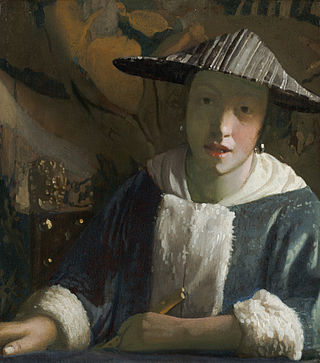
Girl with a Flute is a small painting attributed to either Johannes Vermeer or one of his associates. It is currently believed to have probably been painted between 1669–1675. It is owned by the National Gallery of Art in Washington, D.C. along with three paintings attributed to Vermeer: Woman Holding a Balance, A Lady Writing a Letter, and Girl with a Red Hat.

The Goldfinch is a painting by the Dutch Golden Age artist Carel Fabritius of a life-sized chained goldfinch. Signed and dated 1654, it is now in the collection of the Mauritshuis in The Hague, Netherlands. The work is a trompe-l'œil oil on panel measuring 33.5 by 22.8 centimetres that was once part of a larger structure, perhaps a window jamb or a protective cover. It is possible that the painting was in its creator's workshop in Delft at the time of the gunpowder explosion that killed him and destroyed much of the city.

A View of Delft, with a Musical Instrument Seller's Stall is a 1652 painting by Carel Fabritius. It is an oil painting on canvas of 20.9 by 35.7 cm of a cityscape of Delft. The work has been in the collection of the National Gallery in London since 1922. The unusual perspective distortion, especially visible to the right of the church, suggests that it may have been intended to have been displayed on a curved surface at the back of a perspective box hence making an illusion of anamorphosis. Fabritius is mentioned in contemporary documents in connection with perspective boxes. The view is of the Nieuwe Kerk facing the Town Hall and several houses, one of which is still extant, at the point where the Oude Langendijk canal meets the Vrouwenrecht. The size of the canvas, exceptionally small for a cityscape of its kind, also supports the perspective-box hypothesis. Another possibility is that Fabritius designed the picture with the aid of a double-convex lens, as these may create distorted proportions in a pattern akin to those seen in the painting. However, material analyses carried out during conservation strengthen the possibility of the perspective-box view.

Johannes Vermeer was a Dutch Baroque Period painter who specialized in domestic interior scenes of middle class life. His works have been a common theme in literature and films in popular culture since the rediscovery of his works by 20th century art scholars.
Pieter Roelofs is a Dutch art historian working for the Rijksmuseum in Amsterdam as head of paintings and sculpture. He is specialised in Dutch Golden Age painting, particularly Rembrandt van Rijn.
